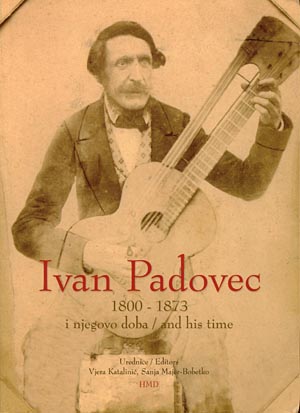

A MUST HAVE FOR ALL
GUITAR HISTORIANS!

|
Edited by Vjera Katalinić – Sanja Majer-Bobetko Articles are in Croatian with summaries in English, and one in English with summary in Croatian.
The latter will be of particular
interest to harp guitar researchers and historical guitar scholars. It is titled
"Guitars with Extra Bass Strings. Johann Georg Stauffer, His Son
Johann Anton Stauffer and Their Contemporaries." In these
50 pages plus 41 pages of photographs (the majority in full color) Alex
Timmerman (Netherlands) presents an exhaustive investigation into
European bass-guitars (harp guitars). Alex provides this summary of his chapter: The remainder of the book presents the life, times and music of Ivan Padovec - no stranger to Early Romantic guitar players and scholars, but little known (until now) to the rest of us. On September 28-30, 2000, a celebration of the 200th anniversary of the birth of the guitar virtuoso and composer Ivan Padovec was held in Varaždin and Zagreb under the patronage of the Department for Musical Art and Musicology of the Croatian Academy of Sciences and Arts, organized by its Department for History of Croatian Music, Institute for the Scientific Work of the Academy in Varaždin, Croatian Musicological Society, Croatian Music Institute and the State Archives in Varaždin. The proceedings encompassed all reviewed and accepted papers: some of them bringing to light new elements of Padovec’s biography, some investigating his opus and bringing new data on their number, chronology, and correcting some previous mistakes, and a thematic catalog was established. Some audio and audio-visual recordings were presented, and upon the analysis of these works, the variety of Padovec's compositional output was brought to light, stressing his interpretative characteristics and the context of his pedagogical activity in his time. Especially important, his guitar manual Škola za gitaru was analyzed, as was his well-known guitar with ten strings. An entire critical introspection of the reception of Padovec’s activity in the Croatian musical historiography was done, and social aspects of his activity were investigated, especially those in connection with the then contemporary social status of musicians. Later on, the proceedings present some aspects of the musical culture in Zagreb during Padovecs time, and – for the first time in Croatian musicology – give insight into the problem of virtuosity, in connection with the 19th-century music, and its historical changes. A thorough bibliography of texts on Ivan Padovec closes the proceedings. 400+ pages, 7 x 9-1/2", paper |
|
CDs &
DVDs by Stephen Bennett, John Doan, Muriel Anderson, Andy McKee,
Stacy Hobbs, Tom Shinness, Dan LaVoie, James Kline, Larry
Berwald, Bill Dutcher, Gregg Miner, Pasquale Taraffo |
All Site Contents ©
2006-2021

PO Box 573155
Tarzana, CA 91357
USA
(818) 884-7937